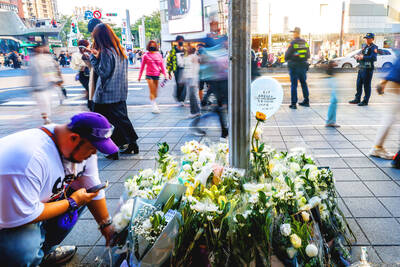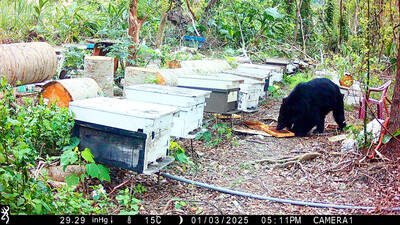A draft act on uncrewed aerial vehicle (UAV) experiments has been sent to the Cabinet, a Ministry of Science and Technology (MST) official said yesterday, expressing the hope that it would enter legislative review in the upcoming session.
UAVs are a crucial technological trend and the most promising application of artificial intelligence, with many technology giants, such as Google and Amazon, investing in their development, Department of Foresight and Innovation Policies Director-General Yang Hsiu-ya (楊琇雅) said.
The Taipei, New Taipei City and Kaohsiung minicipal governments have started working with foreign developers to introduce uncrewed vehicles, she said.
As uncrewed vehicles’ compatibility with real-world environments is key, a major problem for developers is whether transportation laws can be relaxed to allow room for experiments, she said.
Different kinds of vehicles are subject to different laws — land vehicles are regulated by the Highway Act (公路法) and marine vessels by the Ships Act (船舶法) — but it would be extremely difficult for the government to amend existing laws to accommodate innovations in UAVs, she said.
Therefore, the ministry has laid out fundamental regulations for uncrewed ground, sea and aerial vehicles, which can facilitate the work of the Ministry of Transportation and Communications to revise its administrative guidelines, she said.
The Cabinet is weighing whether UAVs should be supervised by the science ministry or the transportation ministry and a decision should be reached before the bill enters legislature review, she said.
The science ministry plans to establish a cross-ministerial committee to review applications for uncrewed vehicle experiments and required security measures, while the transportation ministry would be in charge of real-world testing of the vehicles, she said.
The committee would determine which UAVs are necessary and innovative, but could breach laws, and then offer suggestions to the transportation ministry, Yang said, adding the the latter would give the final approval to vehicle developers and regulate their traffic.

SHIPS, TRAINS AND AUTOMOBILES: The ministry has announced changes to varied transportation industries taking effect soon, with a number of effects for passengers Beginning next month, the post office is canceling signature upon delivery and written inquiry services for international registered small packets in accordance with the new policy of the Universal Postal Union, the Ministry of Transportation and Communications said yesterday. The new policy does not apply to packets that are to be delivered to China, the ministry said. Senders of international registered small packets would receive a NT$10 rebate on postage if the packets are sent from Jan. 1 to March 31, it added. The ministry said that three other policies are also scheduled to take effect next month. International cruise ship operators

NUMBERS IMBALANCE: More than 4 million Taiwanese have visited China this year, while only about half a million Chinese have visited here Beijing has yet to respond to Taiwan’s requests for negotiation over matters related to the recovery of cross-strait tourism, the Tourism Administration said yesterday. Taiwan’s tourism authority issued the statement after Chinese-language daily the China Times reported yesterday that the government’s policy of banning group tours to China does not stop Taiwanese from visiting the country. As of October, more than 4.2 million had traveled to China this year, exceeding last year. Beijing estimated the number of Taiwanese tourists in China could reach 4.5 million this year. By contrast, only 500,000 Chinese tourists are expected in Taiwan, the report said. The report

HORROR STORIES: One victim recounted not realizing they had been stabbed and seeing people bleeding, while another recalled breaking down in tears after fleeing A man on Friday died after he tried to fight the knife-wielding suspect who went on a stabbing spree near two of Taipei’s busiest metro stations, Taipei Mayor Chiang Wan-an (蔣萬安) said. The 57-year-old man, identified by his family name, Yu (余), encountered the suspect at Exit M7 of Taipei Main Station and immediately tried to stop him, but was fatally wounded and later died, Chiang said, calling the incident “heartbreaking.” Yu’s family would receive at least NT$5 million (US$158,584) in compensation through the Taipei Rapid Transit Corp’s (TRTC) insurance coverage, he said after convening an emergency security response meeting yesterday morning. National

The Forestry and Nature Conservation Agency yesterday launched a gift box to market honey “certified by a Formosan black bear” in appreciation of a beekeeper’s amicable interaction with a honey-thieving bear. Beekeeper Chih Ming-chen (池明鎮) in January inspected his bee farm in Hualien County’s Jhuosi Township (卓溪) and found that more than 20 beehives had been destroyed and many hives were eaten, with bear droppings and paw prints near the destroyed hives, the agency said. Chih returned to the farm to move the remaining beehives away that evening when he encountered a Formosan black bear only 20m away, the agency said. The bear